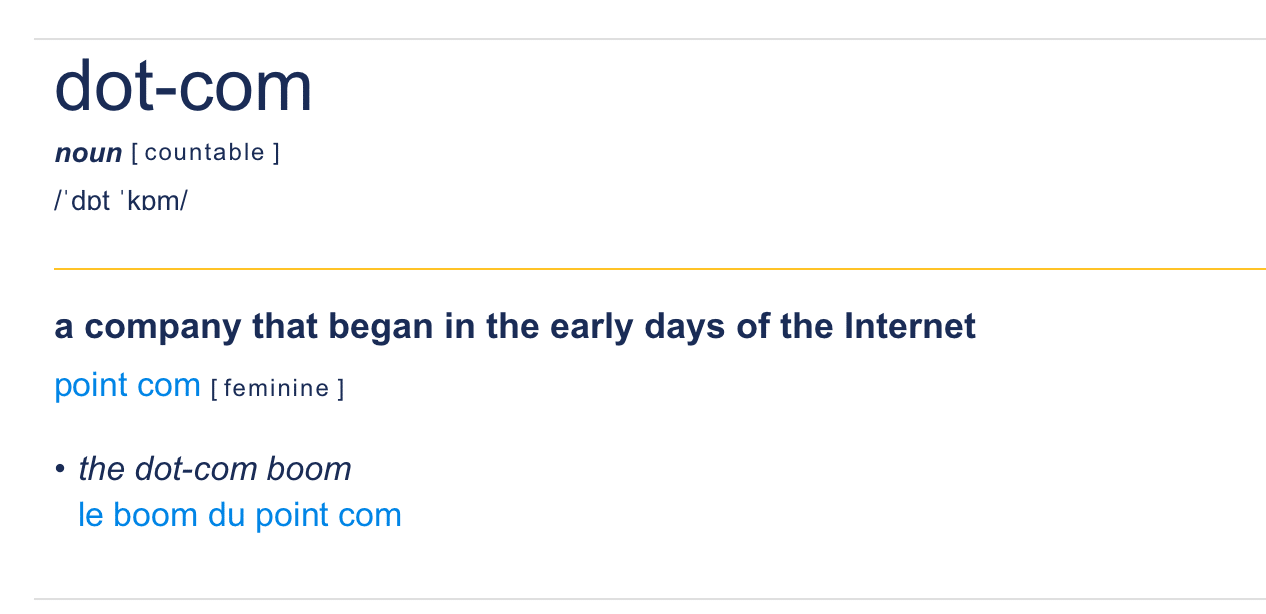Picking the right domain name is one of the most important steps in starting your online business. You want your customers, business partners and investors to find your website quickly, easily, and remember it for future visits. Your domain has a direct effect on all your marketing efforts as it ultimately influences how your audience perceives your company. We’ve covered in more detail how to go about securing a good domain for your business. But what extension to use? We hope this will help you make a choice that will get your brand the attention and recognition it deserves.
.com
The .com extension is one of the original seven top-level domains (TLDs) on the Internet, when the Domain Name System was implemented in January 1985 (we’ll cover the other six below).
.com derives from « commercial » as the extension was intended to be used for commercial organizations. For the past 36 years since its creation, .com has become a brand of itself.

Over half of all domain names globally are in the .com extension. Generations of people have typed .com over the years every time they want to access a business online. The extension has been used in advertising campaigns on TV, print and radio and billions of dollars have been spent over the past nearly four decades to cement .com as the natural, intuitive choice for accessing a business online. Like it or not, if you are running a business on another extension, you are losing visitors (and likely emails) to the .com. How many? That would depend, but it’s proportional to your marketing efforts.
The .Com is also the choice of many SEO experts and has become so deeply ingrained in common language, that you can find it as a noun in the Cambridge Dictionary.

So far it looks like .com is the perfect extension to choose for your business, right? Well, with all the arguments in favor, there is one little problem – your desired .com is likely taken. Domain names are unique and as the oldest and most popular extension, pretty much all good, brandable, meaningful .com names have already been registered. That is not to say you have to give up – there may be a way to get the name you want. But it will likely take some research, effort, time and money.
Here are some tips on how to go about buying a domain name that is already owned by someone.
You don’t need to search hard to find known brands using the .com extension – over 83% of Fortune 500 companies use .com for their online presence, and 100% of the top tech companies by market share are on .com.
Effectively, it is not a domain name you are investing in, when you get the matching .com for your brand. It is the opportunity not to have to spell out the extension every time you mention your brand name.
How many times have you seen Chanel putting Chanel.com on their ads? They don’t. Because everyone naturally knows you can find them there.

.net
.Net is another gTLD, it is also the fifth most popular extension after .com, .tk,,.cn and .de. Net derives from the word network and was originally intended for organizations involved in networking technologies. There are no official restrictions to register a .net so since its introduction in 1985 it has been used for all sorts of businesses, often as an alternative to .com.
The first .net domain registered was Nordu.net, a non-profit company based in Denmark. Other famous .net brands are ASP.NET – an open-source web framework, created by Microsoft and Artsy.net
.org
.Org is another top-level domain extension, dating back to 1985. It is an abbreviation for « organization » and was initially meant to be used for organizations that don’t fit under the other initial seven extensions available. In the years to follow .org became the chosen extension for non-profits, open-source projects, and communities, which is how it is perceived now.
Up to 2019, there was a restriction to who can register a .org since it was operated by a non-profit. After the registry was sold to an investment firm, those restrictions were lifted and now anyone can register a .org. About 4,5% of all registered domains globally are .org.
Many global businesses run their social responsibility efforts and community projects on a .org. For example, we all know where Google.com goes, and on Google.org you will find the company’s efforts to help solve global challenges.
Notable .org businesses are Wikipedia.org (they also have the .com), Archive.org, Cambridge.org, and NPR.org (they also have the .com).
Country extensions
Country code top-level domains (ccTLD) are top-level domain extensions reserved for a specific country. Those extensions are subjected to requirements that are determined by each country’s domain name regulation corporation. Some ccTLDs you probably know are .us, .co.uk, .fr, .ru. Others got popular for their creative use – like .me for Montenegro, .ai for Anguilla, or .io for British Indian Ocean Territory.
The first registered ccTLD was .no, for Norway, it was registered in 1983.
While country domain extensions allow for some creativity, there are some downsides to using those if you are in business for the long run.
First, prices can vary – .ai for example will cost you about $50/year on renewals (compared to $8 for .com), and a .pr (the country extension for Puerto Rico) will cost you around $1,200 yearly on renewal fees.
Second-country extensions are governed by their respective state, and so prone to be affected by any developments with the country in question. For example, the country code .cs used to belong to Czechoslovakia. After the country split in 1993, it was deleted in 1995. Later on, in 2003, .cs became the extension for Serbia and Montenegro, but again, not for long! It was split to .rs for Serbia and .me for Montenegro when the country split in 2006. Imagine running a business on that!
A more recent example of how country domain extensions can prove unsafe for global businesses is related to Brexit when tens of thousands of UK-based businesses got their .eu domains suspended. Another one is the scandal around .io about how funds from the sale of the domains with the .io extension have been abused. The dispute over the .io extension’s ownership is still ongoing and is treated as a geopolitical matter. The Chagossians claim that .io domain registrations bring in fees of $10 million each year, and the ccTLD has an overall value of around $50 million (of which they, as the former inhabitants forcibly removed by the British government, have seen nothing).
So, what is the best extension to use for your business?
Well, it looks like it depends. If you are targeting a local, country-specific audience, you may be able to get away with just the ccTLD for that territory. If you are testing an idea and not sure it will work out in the future – creative solutions with new extensions may be the way to go – they are relatively cheap and you are more likely to find your brand name available in .shop extension than in .com. If you are building a business with the idea that it will last, develop and grow globally, anything but the matching .com will be a compromise. Fair enough, we don’t always get what we want and life is full of compromises. It is good to be aware of those however so that you are able to make effective decisions when it comes to your business wellbeing and reduces any risks related to using a compromised domain.
We hope the above information will help you in making informed decisions about your brand. If you want to say hi or have any questions about naming, branding, and domain names get in touch, we’re always happy to hear from you.
branding domain domain extension domain name domain names domains startup

Previous Next